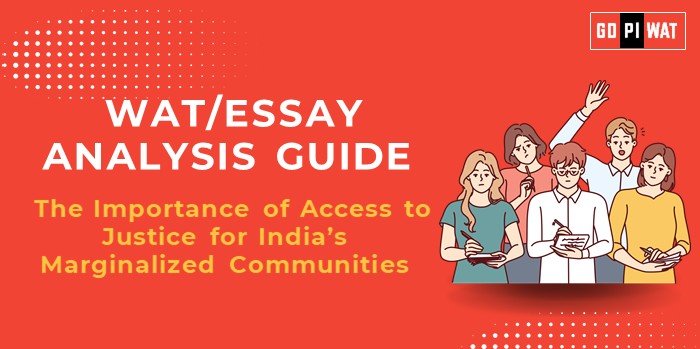body>
📋 Written Ability Test (WAT)/Essay Analysis Guide: The Importance of Access to Justice for India’s Marginalized Communities
🌐 Understanding the Topic’s Importance
Access to justice is not only a legal but also a socio-economic issue. Its significance lies in promoting equality and reducing systemic oppression, aligning with SDG 16: Peace, Justice, and Strong Institutions. Ensuring equitable access to legal mechanisms is essential for upholding democratic values and fostering social cohesion.
📝 Effective Planning and Writing
- ⏱️ Time Allocation (30 minutes):
- Planning: 5 minutes
- Writing: 20 minutes
- Review: 5 minutes
🎯 Introduction Techniques for Essays
- ⚖️ Contrast Approach: “While India’s Constitution guarantees equal justice for all, marginalized communities face systemic barriers that hinder their access to these guarantees.”
- 🛠️ Solution-Based Approach: “Bridging India’s justice gap requires reforms in legal aid, technology integration, and awareness campaigns targeting underserved communities.”
📊 Structuring the Essay Body
1. Achievements:
- ⚖️ Legal aid successes through programs like the National Legal Services Authority (NALSA).
- 📚 Regional case studies demonstrating the impact of community legal awareness campaigns.
- 💻 Digital reforms, such as e-Courts, that streamline access to justice.
2. Challenges:
- ⏳ Delays in court proceedings disproportionately affecting marginalized groups.
- 🛑 Limited awareness of legal rights among underserved communities.
- ⚠️ Systemic biases within the judiciary and law enforcement.
3. Future Outlook:
- 📈 Propose technology-driven solutions like mobile legal aid platforms for rural areas.
- 📜 Advocate for policy-based reforms, including fast-track courts and simplified legal processes.
- 🌍 Promote partnerships between NGOs, governments, and private sectors to expand legal outreach.
📖 Concluding Effectively
- ⚖️ Balanced Approach: “Justice remains a work in progress for India’s marginalized, necessitating both systemic reforms and grassroots efforts.”
- 🌍 Global Comparison: “Learning from Brazil and South Africa, India must scale its legal aid mechanisms for inclusive justice delivery.”
📄 Sample Short Essays
1. Balanced Perspective: “Despite significant advancements in legal aid, India’s marginalized communities continue to face barriers to justice. A mix of policy reforms, technology integration, and awareness campaigns can transform access to justice.”
2. Solution-Oriented: “Access to justice for marginalized communities requires systemic changes. Fast-track courts, digital legal aid platforms, and gender diversity in judiciary can ensure inclusivity.”
3. Global Comparison: “India’s efforts in ensuring justice for its marginalized communities are notable. However, adopting models like Brazil’s Public Defenders’ Offices can make access more inclusive.”


